By Leen Randell
Updated: Jul 10, 2024
10 Best Herbal Teas For Tickling Throat
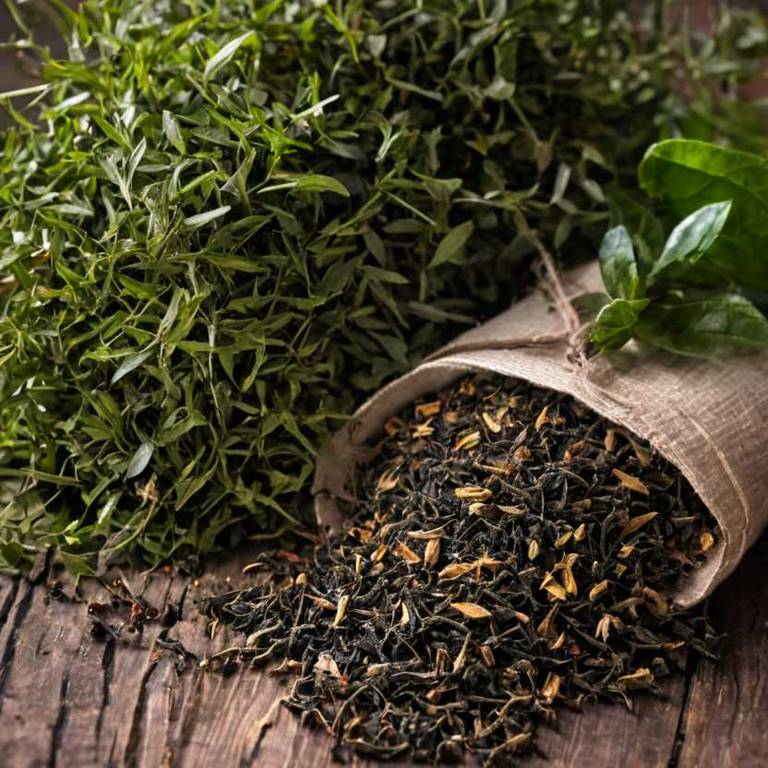
Herbal teas for tickling throat are soothing brews made from plants that help alleviate an itchy, irritating throat.
These teas work by reducing inflammation, calming the mucous membranes, and loosening mucus. Examples of herbal teas that help with tickling throat include slippery elm, marshmallow root, and licorice root tea.
By consuming these teas, individuals can experience relief from discomfort and improved sleep quality, enabling them to live more comfortably and enjoy daily activities without throat irritation.
The following article describes in detail the most important teas for tickling throat, including medicinal properties, parts of herbs to use, and recipes for preparations.
- 1. Thymus vulgaris
- 2. Mentha x piperita
- 3. Glycyrrhiza glabra
- 4. Foeniculum vulgare
- 5. Verbena officinalis
- 6. Sambucus nigra
- 7. Taraxacum officinale
- 8. Matricaria chamomilla
- 9. Echinacea angustifolia
- 10. Lavandula angustifolia
- What is the best combination of herbal teas to use for tickling throat?
- What ailments similar to tickling throat are treated with herbal teas?
1. Thymus vulgaris
Thymus vulgaris, also known as thyme, teas helps with tickling throat because of its natural antiseptic and anti-inflammatory properties.
The essential oils present in thyme, such as thymol and carvacrol, have decongestant and expectorant properties, which help to loosen and clear mucus from the throat, providing relief from tickling and discomfort.
Additionally, thyme's antimicrobial properties help to combat underlying infections that may be contributing to the tickling sensation, promoting a healthy and clear throat.
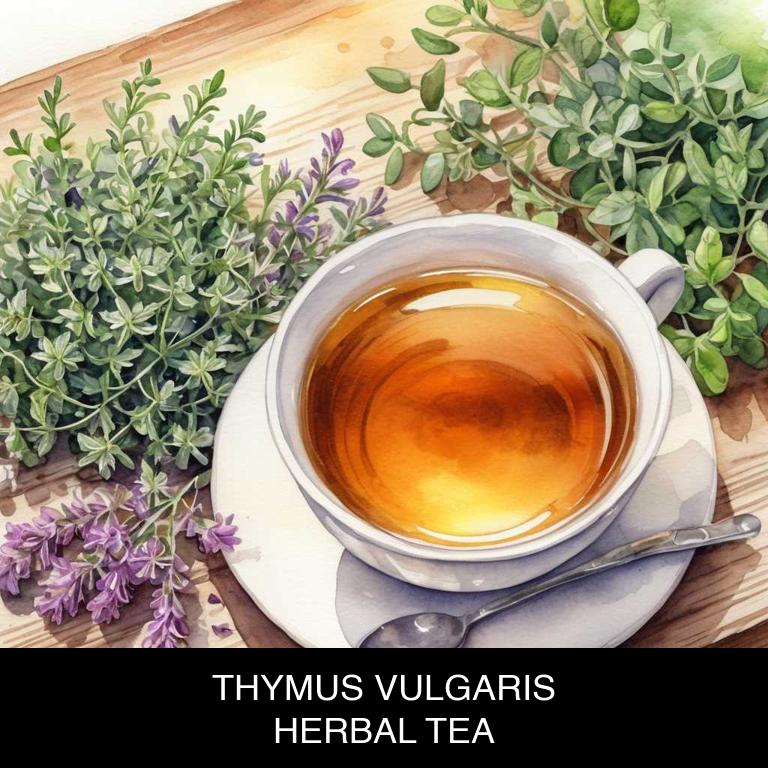
Medicinal Constituents
The list below shows the primary medicinal constituents in Thymus vulgaris teas that help with tickling throat.
- Thymol: Acts as a natural expectorant, helping to loosen and clear mucus from the throat, thereby reducing tickling and discomfort.
- Carvacrol: Exhibits antimicrobial properties, which help combat underlying infections causing the tickling throat, and also has anti-inflammatory effects to soothe the throat.
- Rosmarinic acid: Possesses anti-inflammatory and antioxidant properties, which help reduce swelling and irritation in the throat, thereby alleviating the tickling sensation.
Parts Used
The list below shows the primary parts of thyme used to make teas for tickling throat.
- Leaves: Thymus vulgaris leaves are used to make teas for tickling the throat because of their high content of thymol, a compound with antibacterial and anti-inflammatory properties.
- Flowers: Thymus vulgaris flowers are used to make teas for tickling the throat due to their calming and soothing effects, which can help to reduce throat irritation.
- Buds: Thymus vulgaris buds are used to make teas for tickling the throat because they contain a high concentration of volatile oils, which can help to soothe and calm the throat.
Quick Recipe
The following recipe gives a procedure to make a basic thyme for tickling throat.
- Harvest 1-2 tablespoons of fresh or dried thymus vulgaris leaves and flowers in the early morning.
- Rinse the harvested leaves and flowers with cold water to remove any dirt or debris.
- Steep 1 teaspoon of the harvested material in 8 ounces of boiling water for 5-7 minutes.
- Strain the tea into a cup and discard the solids to prevent any bitterness.
- Allow the tea to cool for 2-3 minutes before serving it hot or iced.
2. Mentha x piperita
Mentha x piperita, also known as peppermint, teas helps with tickling throat because of its natural anti-inflammatory properties.
The menthol content in peppermint helps to numb the throat, reducing irritation and discomfort. Additionally, peppermint tea has a soothing and calming effect on the mucous membranes, which helps to reduce inflammation and ease the tickling sensation in the throat.
This makes peppermint tea a popular remedy for soothing a tickly throat and relieving congestion.
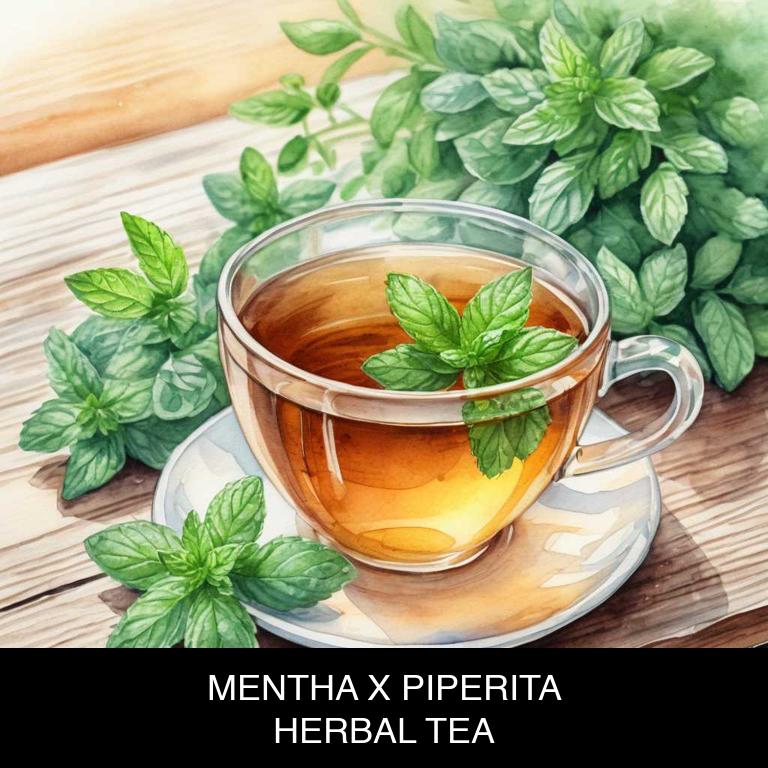
Medicinal Constituents
The list below shows the primary medicinal constituents in Mentha x piperita teas that help with tickling throat.
- Menthone: Acts as a local anesthetic and anti-inflammatory agent, helping to numb and soothe the irritated tissues in the throat, reducing discomfort and tickling sensations.
- Menthol: Exhibits expectorant and decongestant properties, helping to thin mucus and promote its removal from the respiratory tract, thereby reducing the tickling sensation caused by mucus accumulation in the throat.
- Rosmarinic acid: Displays potent anti-inflammatory and antioxidant properties, which help to reduce inflammation and oxidative stress in the throat, thereby alleviating tickling and discomfort associated with throat irritation.
Parts Used
The list below shows the primary parts of peppermint used to make teas for tickling throat.
- Leaves: The leaves are the most widely used part of Peppermint, as they contain a high concentration of menthol, which is responsible for the cooling sensation and decongestant properties.
- Stems: The stems are also used, as they contain menthol and menthone, which help to soothe and calm the throat, making them suitable for teas.
- Buds: The buds are used for their high menthol content, which helps to provide relief from throat irritation and tickling sensations, making them a popular choice for teas.
Quick Recipe
The following recipe gives a procedure to make a basic peppermint for tickling throat.
- Harvest fresh mentha x piperita leaves in the morning after the dew has evaporated for best flavor.
- Rinse the leaves with cool water to remove dirt and debris and pat dry with a paper towel.
- Steep one teaspoon of fresh mentha x piperita leaves in boiling water for three to five minutes.
- Strain the tea mixture through a fine mesh sieve into a cup to remove the leaves completely.
- Serve the tea immediately and drink within 10 to 15 minutes for optimal flavor and benefits.
3. Glycyrrhiza glabra
Glycyrrhiza glabra, also known as licorice, teas helps with tickling throat because of its anti-inflammatory properties.
The active compounds in licorice root, such as glycyrrhizin and flavonoids, have been shown to soothe and calm the mucous membranes in the throat. This reduces inflammation and irritation, providing relief from tickling, itching, and discomfort.
Additionally, licorice teas have a sweet and soothing flavor, which can help to calm the throat and provide instant relief from tickling sensations.

Medicinal Constituents
The list below shows the primary medicinal constituents in Glycyrrhiza glabra teas that help with tickling throat.
- Glycyrrhizin: Glycyrrhizin is a triterpenoid saponin that has anti-inflammatory and soothing properties, which may help reduce inflammation and irritation in the throat, providing relief from a tickling sensation.
- Liquiritigenin: Liquiritigenin is a flavonoid that has anti-inflammatory and antispasmodic properties, which can help relax the muscles in the throat and reduce inflammation, providing relief from a tickling throat.
- Licoricidin: Licoricidin is a flavonoid that has anti-inflammatory and antiviral properties, which may help reduce inflammation and combat viral infections that can cause a tickling throat.
Parts Used
The list below shows the primary parts of licorice used to make teas for tickling throat.
- Roots: They contain glycyrrhizin, a compound that gives licorice root its distinct flavor and anti-inflammatory properties, which helps soothe a sore throat.
- Leaves: They have a similar composition to the roots and contain glycyrrhizin, which provides similar benefits for a tickling throat.
- Barks: The barks of Glycyrrhiza glabra may also be used to make tea, although it is less common, and contain compounds that help with inflammation and soothing the throat.
Quick Recipe
The following recipe gives a procedure to make a basic licorice for tickling throat.
- Rinse 5-7 grams of dried glycyrrhiza glabra roots with filtered water for 5 minutes to remove any impurities.
- Steep the rinsed roots in 250ml of boiling water for 5-7 minutes to release the active compounds.
- Strain the liquid through a fine mesh sieve into a cup to separate the roots from the tea.
- Add honey to taste to sweeten the tea and enhance its flavor and aroma.
- Allow the tea to cool for 10-15 minutes before serving to prevent burns and promote relaxation.
4. Foeniculum vulgare
Foeniculum vulgare, also known as fennel, teas helps with tickling throat because of its natural anti-inflammatory and expectorant properties.
The herb contains compounds like anethole and estragole, which help to soothe and calm the mucous membranes in the throat, reducing irritation and discomfort. Additionally, fennel's carminative properties help to ease digestion, which can contribute to a tickling sensation in the throat.
By promoting healthy digestion and reducing inflammation, fennel teas provide a natural remedy for a tickling throat.
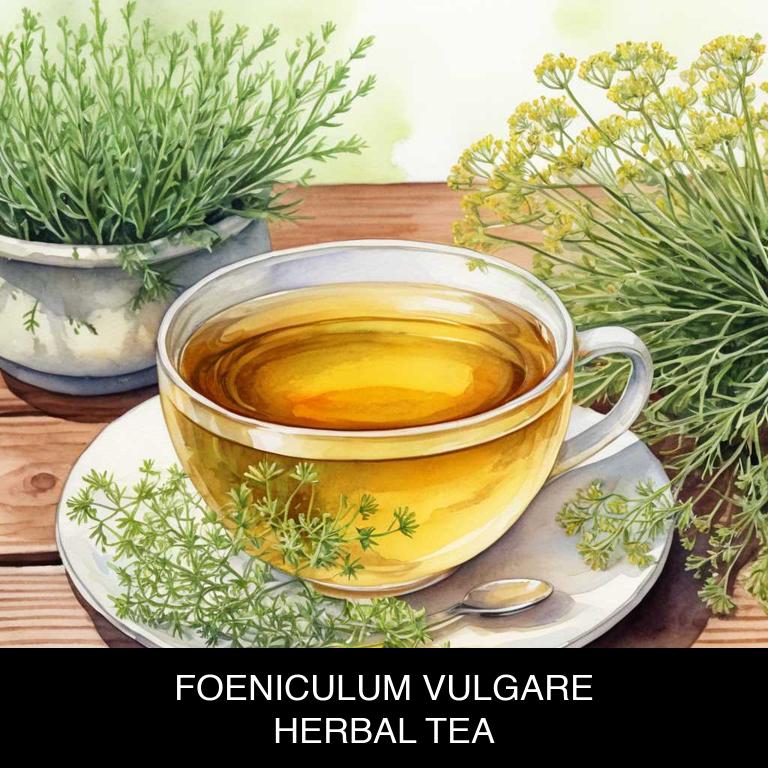
Medicinal Constituents
The list below shows the primary medicinal constituents in Foeniculum vulgare teas that help with tickling throat.
- Anethole: Acts as an anti-inflammatory and expectorant, helping to reduce inflammation and promote the clearance of mucus from the throat, thereby alleviating tickling sensations.
- Foeniculin: Possesses antimicrobial properties, which can help combat infections that may be causing the tickling sensation in the throat, and also has anti-inflammatory effects that can soothe the throat.
- Phenolic acids: Exhibits antioxidant and anti-inflammatory activities, helping to reduce inflammation and protect the mucous membranes in the throat, which can contribute to a tickling sensation.
Parts Used
The list below shows the primary parts of fennel used to make teas for tickling throat.
- Leaves: Foeniculum vulgare leaves are commonly used in teas for tickling throat due to their carminative and anti-inflammatory properties.
- Seeds: Foeniculum vulgare seeds are used in teas for tickling throat as they contain anethole, a compound that helps to relax the muscles and soothe the throat.
- Flowers: Foeniculum vulgare flowers are used in teas for tickling throat due to their antispasmodic properties, which help to calm and relax the muscles in the throat.
Quick Recipe
The following recipe gives a procedure to make a basic fennel for tickling throat.
- Harvest foeniculum vulgare seeds or roots in the early morning after dew has fallen naturally.
- Dry foeniculum vulgare seeds or roots for 7 to 10 days in a warm dry place.
- Crush dried foeniculum vulgare seeds or roots into a fine powder using a mortar and pestle.
- Steep 1 teaspoon of foeniculum vulgare powder in boiling water for 5 to 7 minutes.
- Strain the tea and discard the solids then serve warm or chilled immediately.
5. Verbena officinalis
Verbena officinalis, also known as lemon verbena, teas helps with tickling throat because of its antiseptic and anti-inflammatory properties.
The tea's high content of volatile oils, particularly citral and geranial, soothes and calms the throat, reducing irritation and discomfort. Additionally, its antibacterial properties help combat underlying infections that may be causing the tickling sensation. By consuming Verbena officinalis teas, individuals can find relief from the discomfort and annoyance of a tickling throat.
This natural remedy provides a gentle and effective solution for a healthy throat.
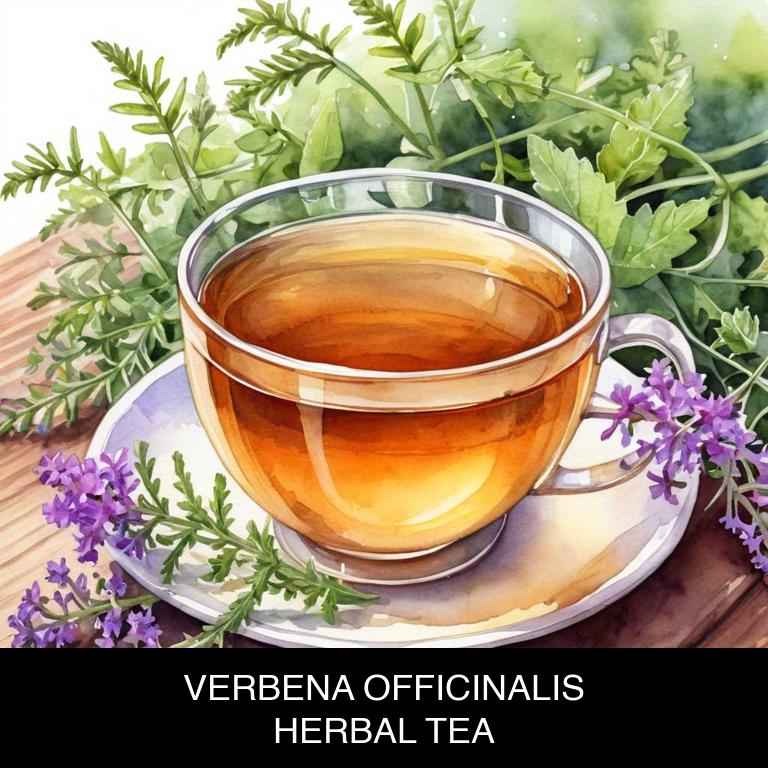
Medicinal Constituents
The list below shows the primary medicinal constituents in Verbena officinalis teas that help with tickling throat.
- Verbenalin: It has anti-inflammatory and antispasmodic properties, which can help soothe and calm the throat muscles, reducing tickling sensations.
- Limonene: As a terpene, limonene has expectorant properties, helping to clear out mucus and phlegm from the throat, making it easier to breathe and reducing tickling sensations.
- Rutin: This flavonoid has anti-inflammatory and antioxidant properties, which can help reduce swelling and irritation in the throat, providing relief from tickling sensations.
Parts Used
The list below shows the primary parts of lemon verbena used to make teas for tickling throat.
- Leaves: The leaves of Verbena officinalis are used to make teas for tickling throat because they contain compounds that help soothe and calm irritated tissues.
- Flowers: The flowers are used to make teas for tickling throat because they possess anti-inflammatory properties that can help reduce swelling and discomfort.
- Roots: The roots of Verbena officinalis are used to make teas for tickling throat because they contain expectorant properties that can help loosen and clear mucus from the respiratory tract.
Quick Recipe
The following recipe gives a procedure to make a basic lemon verbena for tickling throat.
- Harvest fresh verbena officinalis leaves and flowers from a healthy plant in the morning when they are at their peak potency.
- Clean the harvested plant material by gently rinsing it with filtered water to remove any dirt or debris.
- Combine 1 teaspoon of dried verbena officinalis leaves and flowers with 1 cup of boiling water to make a strong infusion.
- Allow the mixture to steep for 5-10 minutes to release the active compounds and essential oils.
- Strain the tea and discard the solids then serve hot or iced depending on your preference.
6. Sambucus nigra
Sambucus nigra, also known as elder, teas helps with tickling throat because of its anti-inflammatory properties and natural antiviral compounds.
The high concentration of flavonoids and anthocyanins in elderberry tea helps to soothe and calm the throat, reducing discomfort and inflammation caused by irritation. This natural remedy is often used to alleviate symptoms of a tickly throat, such as hoarseness and scratchiness, providing quick relief and comfort.
Its effectiveness stems from its ability to promote healing and reduce inflammation.
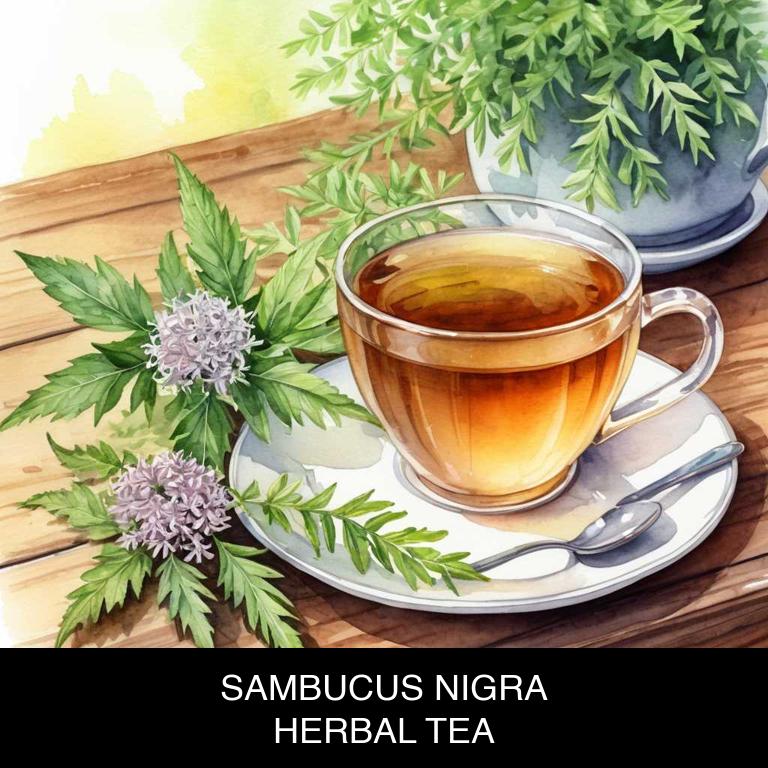
Medicinal Constituents
The list below shows the primary medicinal constituents in Sambucus nigra teas that help with tickling throat.
- Flavonoids: Flavonoids in Sambucus nigra tea help to reduce inflammation and soothe the mucous membranes in the throat, providing relief from tickling and discomfort.
- Phenolic acids: Phenolic acids, such as salicylic acid, have anti-inflammatory and antiseptic properties, which help to calm the throat and reduce irritation that causes tickling.
- Volatile oils: The volatile oils in Sambucus nigra tea, including eugenol and linalool, have analgesic and anti-inflammatory properties, which help to numb the throat and reduce tickling sensations.
Parts Used
The list below shows the primary parts of elder used to make teas for tickling throat.
- Flowers: Rich in antiviral compounds and mucilage, which helps soothe and protect the throat.
- Leaves: Contain bioflavonoids that have anti-inflammatory properties and can help reduce swelling in the throat.
- Stems: The mucilage in Sambucus nigra stems can help coat and soothe the throat, providing relief from tickling sensations.
Quick Recipe
The following recipe gives a procedure to make a basic elder for tickling throat.
- Gather 1-2 pounds of fresh sambucus nigra berries or 1-2 ounces of dried berries.
- Crush the berries to release their active compounds using a mortar and pestle.
- Combine the crushed berries with 1 quart of boiling water in a saucepan.
- Steep the mixture for 5-7 minutes to allow the flavors to infuse.
- Strain the liquid through a cheesecloth or a fine-mesh sieve into a cup.
7. Taraxacum officinale
Taraxacum officinale, also known as dandelion, teas helps with tickling throat because of its anti-inflammatory properties and soothing effects on the mucous membranes.
The tea's high content of vitamins A, C, and K, as well as minerals like potassium and calcium, help to calm the throat and reduce irritation.
Additionally, dandelion's natural antihistamine properties can help to alleviate allergic reactions that may cause a tickling or itchy throat, providing relief and comfort to those experiencing this uncomfortable symptom.
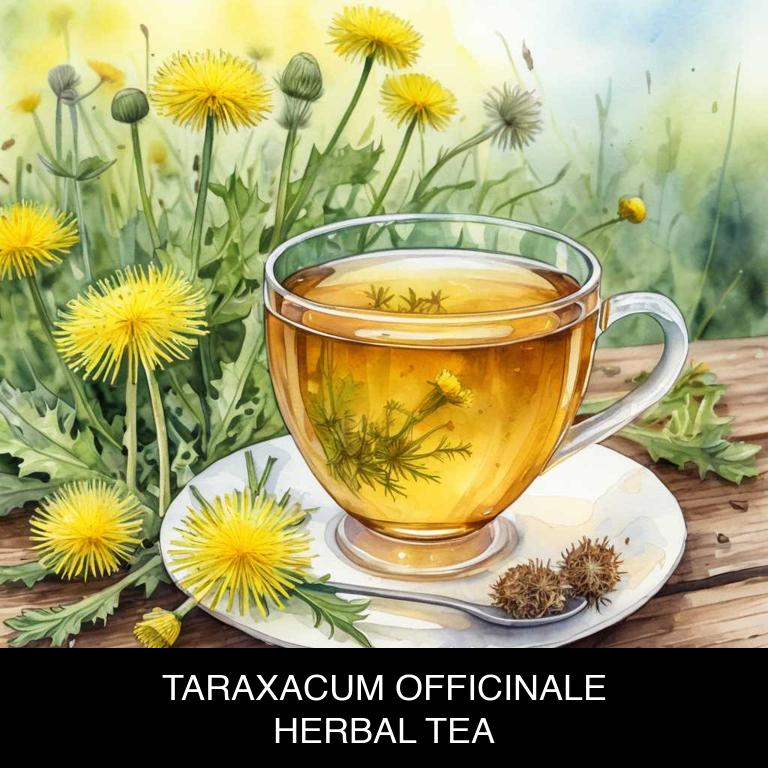
Medicinal Constituents
The list below shows the primary medicinal constituents in Taraxacum officinale teas that help with tickling throat.
- Flavonoids: Flavonoids in Taraxacum officinale tea, such as quercetin and kaempferol, help reduce inflammation and soothe the mucous membranes in the throat, which can alleviate tickling sensations.
- Phenolic acids: Phenolic acids like caffeic acid and ferulic acid in the tea possess anti-inflammatory and antioxidant properties, which can help calm the throat and reduce irritation, thereby relieving tickling sensations.
- Saponins: Saponins, a type of triterpene glycoside, in Taraxacum officinale tea have anti-inflammatory and soothing properties that can help calm the mucous membranes in the throat, reducing irritation and tickling sensations.
Parts Used
The list below shows the primary parts of dandelion used to make teas for tickling throat.
- Leaves: The leaves of Taraxacum officinale contain compounds that help soothe and calm the throat, making it a popular ingredient in herbal teas.
- Flowers: The flowers of Taraxacum officinale are used to make teas that can help reduce inflammation in the throat and promote a soothing effect.
- Roots: The roots of Taraxacum officinale contain a range of compounds that can help to reduce swelling and soothe the throat, making it a popular ingredient in herbal teas for tickling the throat.
Quick Recipe
The following recipe gives a procedure to make a basic dandelion for tickling throat.
- Harvest fresh taraxacum officinale leaves and flowers in the morning after the dew has evaporated for optimal flavor.
- Rinse the harvested plant material with cool water to remove any dirt or debris from the roots.
- Chop the plant material into small pieces to release its natural oils and flavors during steeping.
- Steep one teaspoon of chopped taraxacum officinale in a cup of boiling water for five to ten minutes.
- Strain the tea and discard the solids before serving and enjoy as a refreshing herbal beverage.
8. Matricaria chamomilla
Matricaria chamomilla, also known as chamomile, teas helps with tickling throat because of its anti-inflammatory and soothing properties.
The tea's active compounds, such as apigenin and luteolin, work to calm the mucous membranes in the throat, reducing irritation and discomfort. Additionally, chamomile tea's anti-spasmodic effects can help relax the muscles in the throat, allowing for smoother and more comfortable breathing.
As a result, chamomile tea is often used as a natural remedy to alleviate tickling and irritation in the throat.
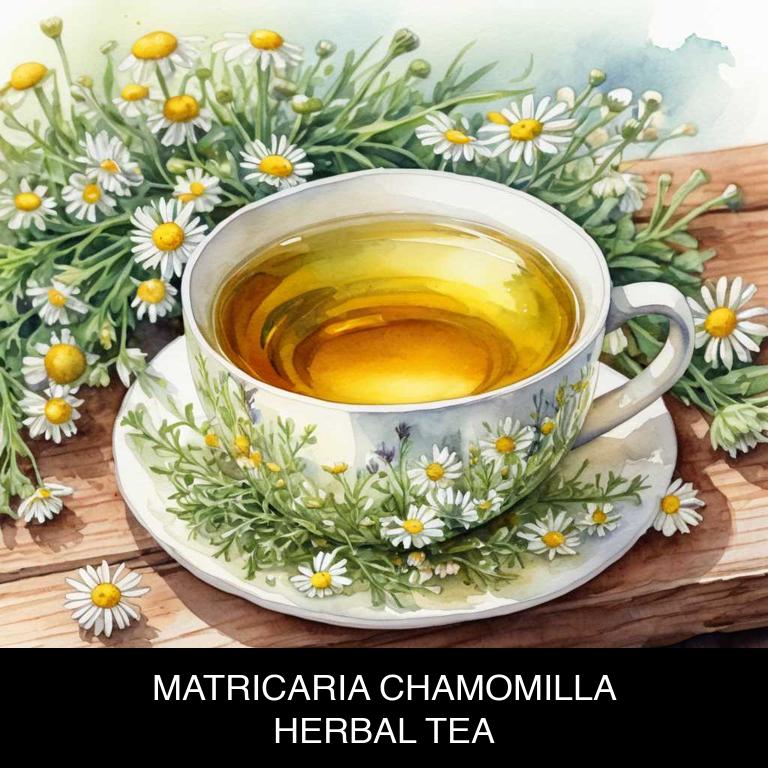
Medicinal Constituents
The list below shows the primary medicinal constituents in Matricaria chamomilla teas that help with tickling throat.
- Apigenin: An apigenin is a flavonoid that helps soothe and calm the throat, reducing inflammation and discomfort associated with a tickling throat.
- Luteolin: Luteolin is a flavonoid that has anti-inflammatory properties, which help to reduce swelling and irritation in the throat, providing relief from a tickling sensation.
- Bisabolol: Bisabolol is a sesquiterpene that has anti-inflammatory and antiseptic properties, which help to soothe and protect the mucous membranes of the throat, reducing the discomfort and tickling associated with a sore throat.
Parts Used
The list below shows the primary parts of chamomile used to make teas for tickling throat.
- Flowers: The flowers are commonly used to make teas due to their anti-inflammatory and soothing properties, which can help calm a sore throat.
- Leaves: The leaves contain flavonoids and other compounds that contribute to their soothing and anti-inflammatory effects, making them suitable for teas to soothe a tickly throat.
- Seeds: Although less commonly used than the flowers, the seeds of Matricaria chamomilla may also be used in teas to take advantage of their expectorant properties, helping to loosen and clear mucus from the throat.
Quick Recipe
The following recipe gives a procedure to make a basic chamomile for tickling throat.
- Gather 1 to 2 teaspoons of dried matricaria chamomilla flowers or 2 to 3 teaspoons of fresh flowers.
- Steep the flowers in 1 cup of boiling water for 5 to 7 minutes.
- Strain the liquid through a fine-mesh sieve into a cup to remove the flowers.
- Allow the tea to cool for 2 to 3 minutes before serving.
- Drink the tea hot or at room temperature within 30 minutes to 1 hour.
9. Echinacea angustifolia
Echinacea angustifolia, also known as Kansas coneflower, teas helps with tickling throat because of its anti-inflammatory properties and ability to soothe irritated mucous membranes.
The plant's roots and flowers contain compounds that have been shown to reduce swelling and ease congestion, providing relief from tickling and discomfort in the throat.
By promoting a healthy immune response and reducing inflammation, Echinacea angustifolia tea can help alleviate the underlying causes of a tickling throat, making it a popular natural remedy for respiratory issues.
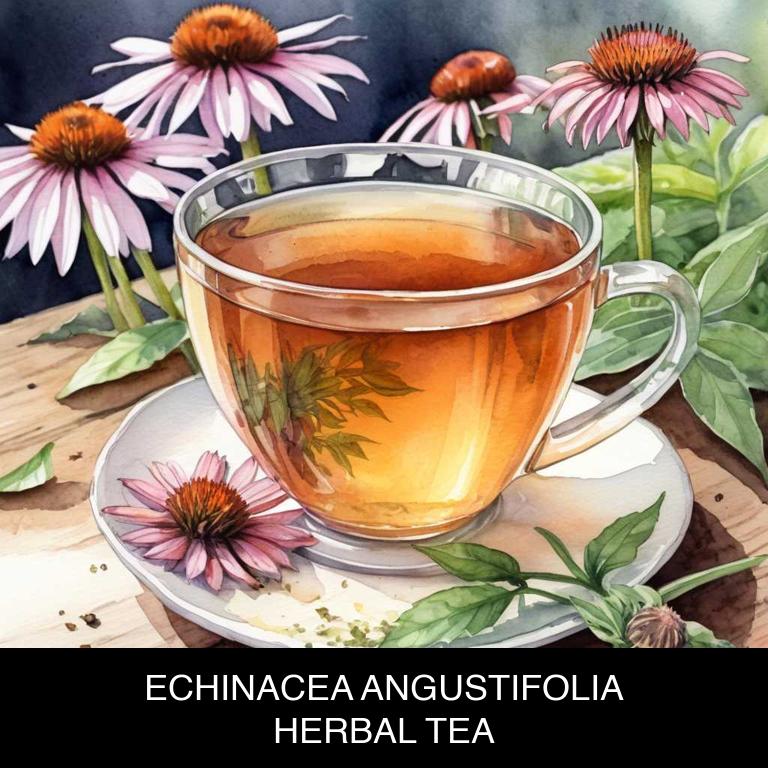
Medicinal Constituents
The list below shows the primary medicinal constituents in Echinacea angustifolia teas that help with tickling throat.
- Iridoid glycosides: These compounds may help reduce inflammation and soothe an irritated throat, providing relief from tickling sensations.
- Polyacetylenes: These compounds have shown antimicrobial properties, which can help combat the underlying infections causing throat irritation and tickling.
- Flavonoids and phenolic acids: These compounds have anti-inflammatory and antioxidant properties, which can help reduce inflammation and soothe the throat, providing relief from tickling sensations.
Parts Used
The list below shows the primary parts of kansas coneflower used to make teas for tickling throat.
- Roots: They contain a high concentration of echinacoside, a compound with anti-inflammatory properties that helps soothe a sore throat.
- Leaves: They have a mild flavor and are often combined with roots to create a balanced tea that can help alleviate throat discomfort.
- Flowers: They are used for their subtle floral flavor and are often added to teas made from other parts to create a soothing and calming effect.
Quick Recipe
The following recipe gives a procedure to make a basic kansas coneflower for tickling throat.
- Gather echinacea angustifolia roots in sufficient quantities for your tea preparation needs.
- Dry the echinacea angustifolia roots in a well-ventilated area at 50 degrees celsius for 2 hours.
- Measure one teaspoon of the dried roots per cup of boiling water for the herbal tea.
- Steep the dried roots in boiling water for 5 to 7 minutes to release the medicinal properties.
- Strain the tea and serve it hot or cold as needed to promote immune system function.
10. Lavandula angustifolia
Lavandula angustifolia, also known as English lavender, teas helps with tickling throat because of its soothing properties and natural anti-inflammatory compounds.
The tea's calming effects help to reduce irritation and inflammation in the throat, providing instant relief from discomfort. The flavonoids and terpenes present in the tea work together to calm the throat muscles, reducing the sensation of tickling and allowing for easier swallowing.
This makes Lavandula angustifolia tea a popular remedy for soothing a tickling throat and promoting overall respiratory health.

Medicinal Constituents
The list below shows the primary medicinal constituents in Lavandula angustifolia teas that help with tickling throat.
- Linalool: This terpene acts as a natural anti-inflammatory and antispasmodic, helping to reduce swelling and muscle contractions in the throat, thus alleviating tickling sensations.
- Linalyl acetate: Another terpene, linalyl acetate, has a soothing effect on the throat and mucous membranes, reducing inflammation and calming irritated tissues, which helps to stop the tickling sensation.
- Apigenin: This phenolic compound has anti-inflammatory and antihistamine properties, which help to reduce swelling and alleviate allergic reactions that may be contributing to the tickling sensation in the throat.
Parts Used
The list below shows the primary parts of english lavender used to make teas for tickling throat.
- Flowers: These are the most commonly used part of Lavandula angustifolia for teas, as they contain the essential oils that provide the soothing and calming effects.
- Leaves: The leaves are often used in combination with the flowers, as they have a similar composition and can enhance the overall effect of the tea.
- Stems: The stems of Lavandula angustifolia can also be used to make tea, although they may have a slightly different flavor profile compared to the flowers and leaves.
Quick Recipe
The following recipe gives a procedure to make a basic english lavender for tickling throat.
- Harvest 25-30 fresh lavandula angustifolia flowers in the early morning when the dew is still present on the plants.
- Rinse the harvested flowers gently with cold water to remove any dirt or impurities from the plant.
- Combine 1 teaspoon of dried lavandula angustifolia flowers or 2 teaspoons of fresh flowers with 8 ounces of boiling water in a teapot.
- Allow the mixture to steep for 5-7 minutes to release the active ingredients and flavorful compounds from the plant.
- Strain the tea through a fine-mesh sieve or cheesecloth into a cup to remove the flower petals and enjoy.
What is the best combination of herbal teas to use for tickling throat?
The best combination of herbal teas that help with tickling throat is a blend of soothing and antibacterial properties.
Slipping elm and licorice root teas work together to calm inflammation and reduce throat irritation. Adding a pinch of thyme and lemon balm tea enhances the antibacterial properties, helping to combat underlying infections.
This balanced blend of herbal teas provides a natural and effective way to soothe a tickling throat, promoting relaxation and overall well-being.
What ailments similar to tickling throat are treated with herbal teas?
Ailments similar to tickling throat that are treated with herbal teas are conditions like sore throats, coughs, and hoarseness.
Herbal teas such as slippery elm, marshmallow root, and licorice root soothe irritated mucous membranes and reduce inflammation, providing relief from discomfort and congestion.
Additionally, teas containing honey, eucalyptus, and peppermint may also help to calm a tickly throat and ease respiratory issues like bronchitis and asthma.